

"Coastal Forces Recollections"
by
Leslie J. Sprigg ex: Leading Telegraphist. RN.
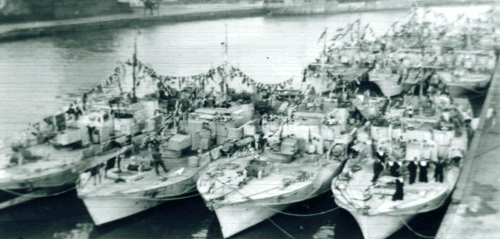
The 63rd MTB Flotilla at Great Yarmouth on VE Day
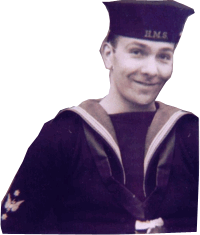
During the war I served in the Royal Navy Coastal Forces,
which consisted of various small craft including Motor Torpedo Boats,
Motor Gunboats, etc. My first boat was ML 108, an ‘A’ Class boat some
110ft, long and initially only armed with .5 Lewis Guns and an old
3 pounder. Only about 12 of these were built. They had 3 Hall-Scott
petrol engines which gave a speed of nearly 30 knots. All were adapted
for minelaying of which we carried any of three main types. There
were ground mines (magnetic), moored mines which we sank to a pre-determined
depth and were activated by a ship striking any one of the numerous
prongs, and magnetic mines which were activated by the rise and fall
of a ship’s engine. As the ship approached, a clapper would start
to rise and continue until maximum. As soon as the ship’s engine started
to fall, the clapper would fall and detonate the mine.
Our task was to lay mines in the coastal shipping supply
lanes close to the shores of France, Belgium and Holland. Leaving
Dover at dusk, we would zig-zag through our own known minefields and
other hazards and head for the coast of France. The engine would be
slowed and silenced (by baffles) as we crept along the coast to our
laying areas. The flotilla would consist of about 6 boats, each carrying
between 5 and 9 mines, according to the type. When in position, the
mines would be laid in 20 second intervals. My job was to call up
to the bridge “Out pins No. 1. Lay No. 1” and so on, until we moved
out of line and the next boat continued the lay. Regarding the mines,
“Out Pins” was the process of activating the mines and disengaging
the straps. Once activated and entering the water, it took about 20
minutes for the soluble plug to dissolve.
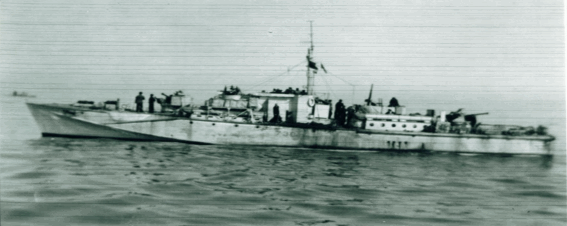
A similiar boat to MTB 753
On completion of our mission, we would move away from
the area and either return to port or look for small enemy craft to
attack. On some occasions, we carried out diversionary attacks to
draw some of the enemy away from a gun battle that was causing them
problems. Our task then was to head in the general direction of the
skirmish andmake a lot of noise (gunfire) to try to draw some of the
enemy away.
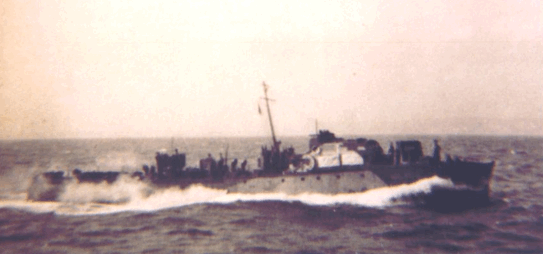
ML108 at speed
Safely back in Dover, we would tie-up alongside, wash
the decks and clean ship before turning in.
Each month we were issued with “comforts” which I had
to collect from a store in the centre of town. These consisted of
a free cigarette and chocolate ration and various knitted items donated
by wellwishers. On one occasion, I borrowed a bike from a lady dockyard
worker, to save the walk into town, and duly collected our allotment.
On the return trip, I was cycling along quite happily, when as I headed
across the main square towards the dockyard, a rather large policeman
on traffic duty, held his hand high. I put the brakes on but nothing
happened. I dropped my feet to the ground and skidded along, but too
late. I hit him amidships. He sat down rather abruptly! I decided
not to hang about so pulled the bike away and pedalled fi.iriously
for the dockyard. Unfortunately, in my hurry, I got caught in the
railway track alongside the jetty. Off I came and the bike and “comforts”
disappeared over the side, into the drink. The dockyard worker proved
to be not such a lady after all although we rescued her bike, and
my shipmates were less than pleased at the loss of their month’s comforts.
I was in fear and trepidation of a large policeman seeking me out.
ML 108 and indeed the rest of the florilla, were versatile
boats. On several occasions we took passengers, (special agents) to
row ashore at a designated spot and some days later, returned to collect
them. This did not always prove successful, either they did not get
to the pick-up area on time, although we always waited as long as
we dare, for the signal, or they had been captured. We would also
take special forces over to one of the harbours, row them in, where
they would select a suitable-sized ship. Having decided on their target,
they would plant limpet mines beneath the hull, swim back to the dinghy,
be rowed back to 108 and off home again. Sounds straightforward, doesn't
it.
I was in my cabin on one minelaying sortie, and about
to lay, when we had a violent crash just behind my cabin. I came off
my seat and turned in time to see the bows of some vessel withdrawing
from the starboard side. There was a heavy mist at the time and we
had no idea what had hit us. They disappeared very quickly. We had
to ditch the mines, and stuff the damaged side with mattresses etc.,
to stem the water. We took in a large amount but managed to return
to Dover where we were patched up then sent to Tough Bros. Yard in
Teddington for repairs. On our way up the Thames the skipper misjudged
the tide, and we lost half the bridge structure passing under one
of the river bridges. We had leave of course whilst repairs were carried
out, and then it was back to Dover.
The minelaying etc., continued until 5th Septemher
1943. We were laying magnetic mines and had just completed our lay,
when there was a huge explosion aft, whici lifted the back end out
of the water. We started to fill quite quickly but at a high level
it seemed to stabilize. We were taken in tow by one of our sister
boats, and headed slowly back towards Dover. Unhappily a large sea
swell developed and the boat gave up the struggle and sank by the
stern. I well remember our First Lieutenant, Hugh Fordham, swimming
round, asking each in turn “Are you all right’?” before shepherding
us to the rescue boat. All the crew were saved and most of us ended
up aboard ML 101.
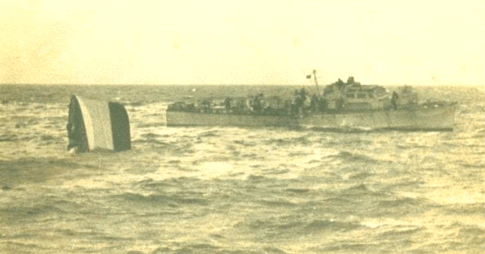
The last moments of ML108 with ML101 picking up survivors,
still a couple of heads bobbing about in the water.
We lost all our personal possessions of course, and
at Dover we were given new clothes and sent to await a new posting.
Not a long wait.
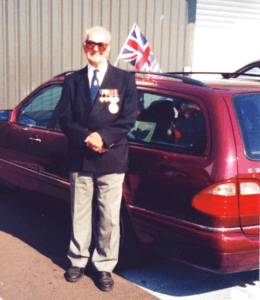 Leslie
at Normandy 6th June 2004
Leslie
at Normandy 6th June 2004
Christopher Ashdown - the son of Lt. Cmdr. Ashdown
(Leslie Sprigg's Commanding Officer) wrote to Leslie about his Father,
this is his reply.
Dear Chris,
I have drawn up some facts and figures re ML104 which
should be of interest to you.
ML104, an ‘A’ class, built by Dickie &
Son, Bangor, Wales in 1940.
Only 12 were built, only 3 survived the war.
Of wood construction, weighing 57 tons, 110 feet long,
they were powered by 3 Hall-Scott petrol engines giving a speed of
around 30 knots. Converted to minelaying in 1942 they carried up to
9 moored mines or 6 ground mines. Armament 1 x 3 pounder, 1 x 20 mm
oerlikon gun and 2 x .303 mgs.
Lt. Cdr. Ashdown was the S.O., 50th ML flotilla for
the whole time I was with them, operating from Dover.
It was said that minelaying, from MLs in particular,
was unspectacular, exciting and nerve racking, requiring a great deal
of skill in station keeping and faultless navigation.
Mines were laid inshore along the enemy coast where
stealth was the order of the day; loaded with high explosives we could
not afford to be engaged by the enemy.
I quote; ‘ On one occasion a force led by Lt.
Cdr.T. Ashdown D.S.O. R.N.R., ran into an enemy convoy on a very dark
night, the convoy was challenged from shore, replied correctly allowing
us to slip through and lay mines as planned, a daring bluff!’
There were occasions when trouble did arise, once in
the form of 2 destroyers, which fired star shells and turned night
into day, then commenced a crossfire, fortunately aiming high, from
which we were lucky to escape with only slight damage. Having ditched
our mines in a hurry and made smoke, we retired at full speed. The
Norwegian flotilla, laying about 2 miles west, witnessed the proceedings
but did not, fortunately, get involved.
One of the most effective lays was a double event, Ashdown’s
MLs set out to lay a field about 2 miles off Calais. By 2300 hours
they were back in Dover, reloaded with mines and sailed again at 0130.
A second field was laid just West of the first. It had taken 12 hours
and gained a special mention from Admiralty.
These are just some of the episodes in the continuing
task of minelaying . I was on ML108 at this time, Lt. Jeffries and
S/Lt. Fordham, and was with the flotilla on every occasion until my
boat was lost on 5th Septermber 1943. Although the main task was minelaying,
single boats would often go on special missions i.e. to drop or recover
special agents or carry out other covert operations.
Your father, Lt. Cdr. Ashdown, was a quiet, dedicated
skipper whose skill and leadership I am sure helped us to survive,
as we did through these many long and arduous ventures along the enemy
coast.
I have enclosed some pictures to help you, the only
one of ML104 is on the ‘remnants’ photo.
Thank you for your interest, I hope I have been able
to help with a brief glimpse into your father’s distinguished
service.
Copyright Text and Images: Leslie J. Sprigg - Also
thanks to Christopher Ashdown and Peter Cheshire.
Back to: Home Page